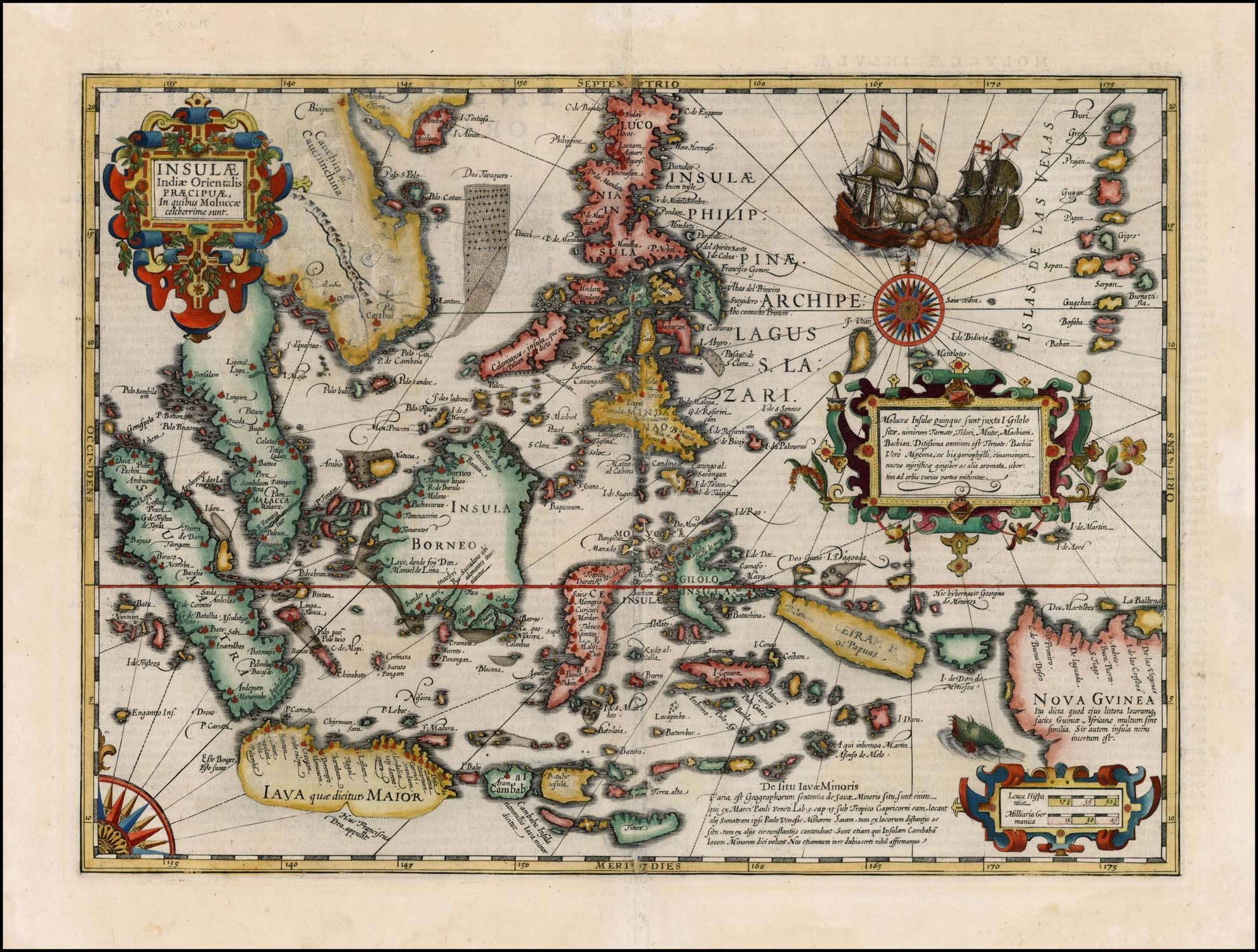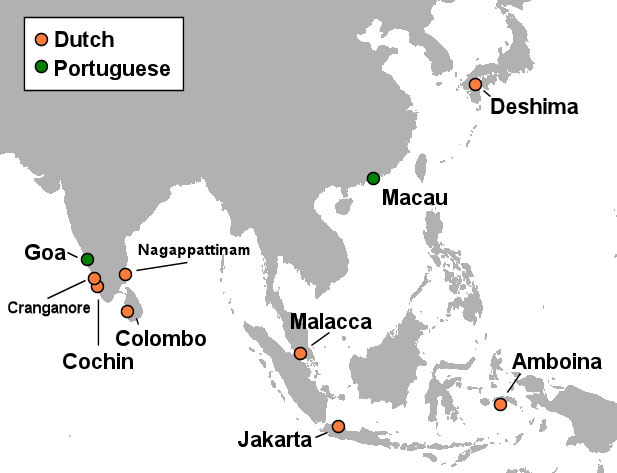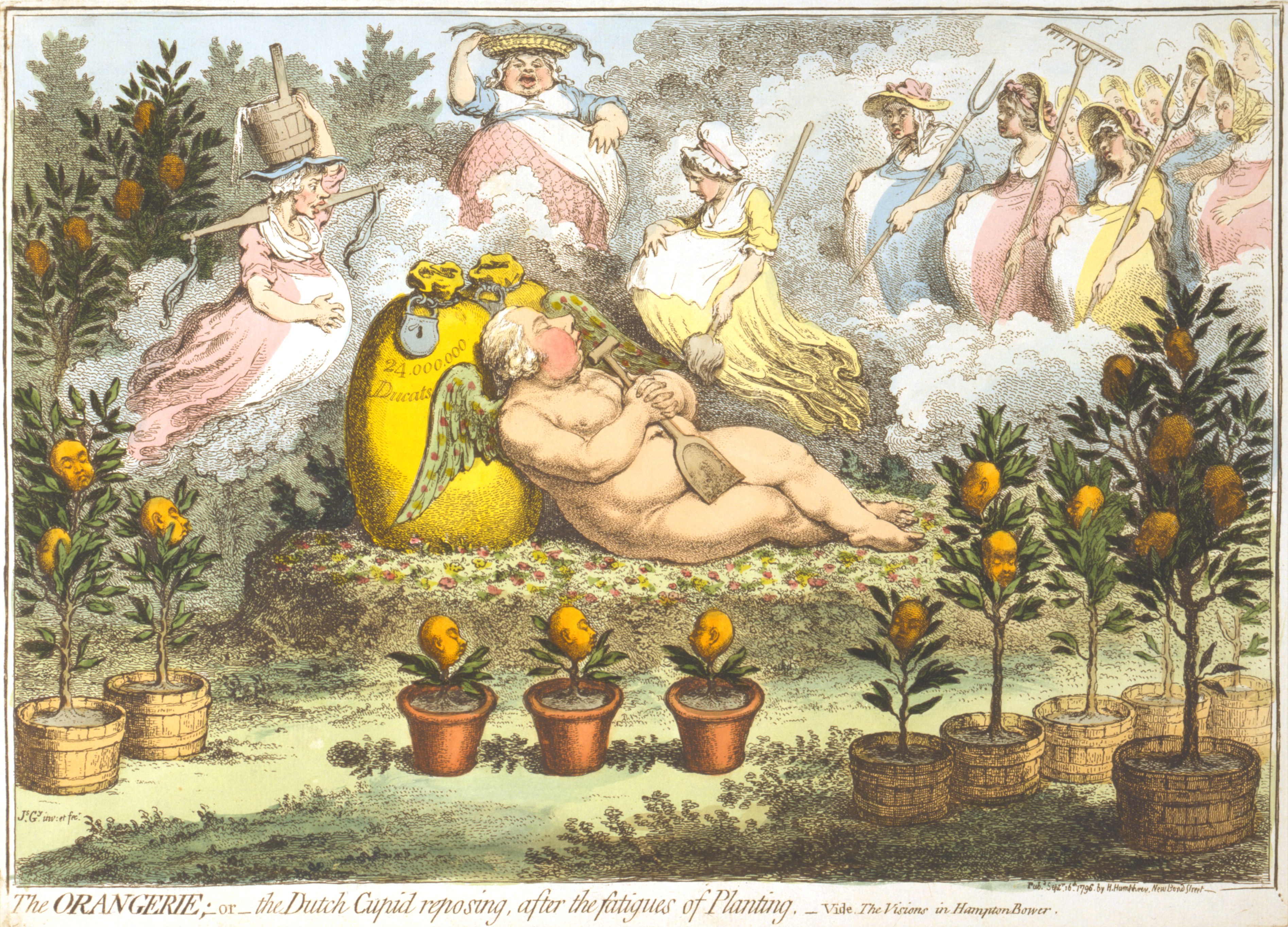|
Capitulation Of Saldanha Bay
The capitulation of Saldanha Bay was the surrender to the British of a Batavian expeditionary force sent to recapture the Dutch Cape Colony in 1796. In 1795, early in the War of the First Coalition, French troops overran the Dutch Republic which then became a French client state, the Batavian Republic. Great Britain was concerned by the threat that the Cape Colony posed to its trade routes to British India. It therefore sent an expeditionary force that landed at Simon's Town in June 1795 and forced the surrender of the colony in a short campaign. British Vice-Admiral Sir George Elphinstone, then reinforced the garrison and stationed a naval squadron at the Cape Colony to protect it. The Batavian government, not yet aware of the capture of the Cape Colony, but worried by rumors of British attacks against colonies of the Dutch East India Company (which was about to be nationalised because it was virtually bankrupt), decided to send a Batavian Navy squadron to the Dutch East In ... [...More Info...] [...Related Items...] OR: [Wikipedia] [Google] [Baidu] |
War Of The First Coalition
The War of the First Coalition () was a set of wars that several European powers fought between 1792 and 1797, initially against the Constitutional Cabinet of Louis XVI, constitutional Kingdom of France and then the French First Republic, French Republic that succeeded it. They were only loosely allied and fought without much apparent coordination or agreement; each power had its eye on a different part of France it wanted to appropriate after a French defeat, which never occurred. Shusterman, Noah (2015). ''De Franse Revolutie (The French Revolution)''. Veen Media, Amsterdam. (Translation of: ''The French Revolution. Faith, Desire, and Politics''. Routledge, London/New York, 2014.) Chapter 7, pp. 271–312: The federalist revolts, the Vendée and the beginning of the Terror (summer–fall 1793). Relations between the French revolutionaries and neighbouring monarchies had deteriorated following the Declaration of Pillnitz in August 1791. Eight months later, Louis XVI and the Leg ... [...More Info...] [...Related Items...] OR: [Wikipedia] [Google] [Baidu] |
Schout-bij-nacht
() is a naval rank of Dutch origin. The was responsible for ensuring that a fleet continued to sail in the prescribed order at night. The title comes from the title of the officer who replaced the admiral at night, from the Middle Low German schulthete meaning commanding official, cognate to the modern German Schultheiß, and was therefore called night commander, captain at night or . Denmark-Norway In the Dano-Norwegian navy, the rank of was codified on 11 February 1693, by King Christian V. In the second publication of the Danish order of precedence, the rank of was placed below vice admirals (), and above Commander-captains (). In 1771, the rank was replaced with Counter admiral. Netherlands It is the second most junior admiral position of the Dutch Navy, ranking above (" commodore") and below a ("vice admiral"). The rank is rated OF-7 within the NATO rank structure, usually equivalent counter admiral, and rear admiral Rear admiral is a flag officer rank ... [...More Info...] [...Related Items...] OR: [Wikipedia] [Google] [Baidu] |
East Indies
The East Indies (or simply the Indies) is a term used in historical narratives of the Age of Discovery. The ''Indies'' broadly referred to various lands in Eastern world, the East or the Eastern Hemisphere, particularly the islands and mainlands found in and around the Indian Ocean by Portuguese explorers, soon after the Cape Route was discovered. In a narrow sense, the term was used to refer to the Malay Archipelago, which today comprises the list of islands of the Philippines, Philippine Archipelago, Indonesian Archipelago, Borneo, and New Guinea. Historically, the term was used in the Age of Discovery to refer to the coasts of the landmasses comprising the Indian subcontinent and the Mainland Southeast Asia, Indochinese Peninsula along with the Malay Archipelago. Overview During the era of History of colonialism, European colonization, territories of the Spanish Empire in Asia were known as the Spanish East Indies for 333 years before the Treaty of Paris (1898), American ... [...More Info...] [...Related Items...] OR: [Wikipedia] [Google] [Baidu] |
Dutch Colonial Empire
The Dutch colonial empire () comprised overseas territories and trading posts under some form of Dutch control from the early 17th to late 20th centuries, including those initially administered by Dutch chartered companies—primarily the Dutch East India Company (1602–1799) and Dutch West India Company (1621–1792)—and subsequently governed by the Dutch Republic (1581–1795) and modern Kingdom of the Netherlands (1815–1975). Following the ''de facto'' independence of the Dutch Republic from the Spanish Empire in the late 16th century, various trading companies known as '' voorcompagnie'' led maritime expeditions overseas in search of commercial opportunities. By 1600, Dutch traders and mariners had penetrated the lucrative Asian spice trade but lacked the capital or manpower to secure or expand their ventures; this prompted the States General in 1602 to consolidate several trading enterprises into the semi-state-owned Dutch East India Company (, VOC), which was gr ... [...More Info...] [...Related Items...] OR: [Wikipedia] [Google] [Baidu] |
Batavian Revolution
The Batavian Revolution () was a time of political, social and cultural turmoil at the end of the 18th century that marked the end of the Dutch Republic and saw the proclamation of the Batavian Republic. The initial period, from about 1780 to 1787, is known as the Patriottentijd or "Time of the Patriots". The power of the "Patriots" grew until the stadtholder, William V felt he had to flee the country in 1785. He asked his brother-in-law Frederick William II of Prussia for help, and in 1787 a relatively small Prussian army restored the Orangists to power with little fighting. After the French Revolution began in 1789, "Patriot" dissent grew, and in the severe winter of 1794/95 a French army with some "Patriot" Dutch units invaded over the frozen frontier rivers, leading to the Batavian Revolution and the proclamation of the Batavian Republic in 1795. The period of Dutch history that followed the revolution is also referred to as the "Batavian-French era" (1795–1813 ... [...More Info...] [...Related Items...] OR: [Wikipedia] [Google] [Baidu] |
Orangism (Dutch Republic)
In the history of the Dutch Republic, Orangism or ''prinsgezindheid'' ("pro-prince stance") was a political force opposing the ''Staatsgezinde'' (pro-Republic) party. Orangists supported the Princes of Orange as Stadtholders (a position held by members of the House of Orange) and military commanders of the Republic, as a check on the power of the '' regenten''. The Orangist party drew its adherents largely from traditionalists – mostly farmers, soldiers, noblemen and orthodox Protestant preachers, though its support fluctuated heavily over the course of the Republic's history and there were never clear-cut socioeconomic divisions. History The coup of stadtholder Maurice against Oldenbarnevelt Orangism can be seen as a continuation of the political opposition between the remonstrants and counter-remonstrants during the Twelve Years' Truce (1609-1621). The Remonstrants were tolerant and republican, with a liberal view on biblical interpretation, no belief in predestination ... [...More Info...] [...Related Items...] OR: [Wikipedia] [Google] [Baidu] |
Patriottentijd
The (; ) was a period of political instability in the Dutch Republic between approximately 1780 and 1787. Its name derives from the Patriots () faction who opposed the rule of the stadtholder, William V, Prince of Orange, and his supporters who were known as Orangism (Dutch Republic), Orangists (). In 1781 one of the leaders of the Patriots, Joan Derk van der Capellen tot den Pol, influenced by the reformer Richard Price and the dissenter Joseph Priestley, anonymously published a pamphlet, entitled ("To the People of the Netherlands"), in which he advocated, like Andrew Fletcher (patriot), Andrew Fletcher, the formation of civic militias on the Scottish, Swiss and American model to help restore the republican constitution. Such militias were subsequently organised in many localities and formed, together with Patriot political clubs, the core of the Patriot movement. From 1785 on, the Patriots managed to gain power in a number of Dutch cities, where they replaced the old system ... [...More Info...] [...Related Items...] OR: [Wikipedia] [Google] [Baidu] |
William V, Prince Of Orange
William V (Willem Batavus; 8 March 1748 – 9 April 1806) was Prince of Orange and the last Stadtholder of the Dutch Republic. He went into exile to London in 1795. He was furthermore ruler of the Principality of Orange-Nassau until his death in 1806. In that capacity, he was succeeded by his son William I of the Netherlands, William. Early life William Batavus was born in The Hague on 8 March 1748, the only son of William IV, Prince of Orange, William IV, who had the year before been restored as stadtholder of the United Provinces. He was only three years old when his father died in 1751, and a long regency began. His regents were: *Anne, Princess Royal and Princess of Orange, Dowager Princess Anne, his mother, from 1751 to her death in 1759; *Landgravine Marie Louise of Hesse-Kassel, Dowager Princess Marie Louise, his grandmother, from 1759 to her death in 1765; *Duke Louis Ernest of Brunswick-Lüneburg, from 1759 to 1766, and kept on as a privy counsellor, in accordance with ... [...More Info...] [...Related Items...] OR: [Wikipedia] [Google] [Baidu] |
Stadtholder
In the Low Countries, a stadtholder ( ) was a steward, first appointed as a medieval official and ultimately functioning as a national leader. The ''stadtholder'' was the replacement of the duke or count of a province during the Burgundian and Habsburg period (1384 – 1581/1795). The title was used for the highest executive official of each province performing several duties, such as appointing lower administrators and maintaining peace and order, in the early Dutch Republic. As multiple provinces appointed the same stadtholder, the stadtholder of the powerful province of Holland at times functioned as the ''de facto'' head of state of the Dutch Republic as a whole during the 16th to 18th centuries, in an effectively hereditary role. For the last half century of its existence, it became an officially hereditary title under Prince William IV of Orange. His son, Prince William V, was the last ''stadtholder'' of all provinces of the Republic, until fleeing French revolutionary tr ... [...More Info...] [...Related Items...] OR: [Wikipedia] [Google] [Baidu] |
Sir George Keith Elphinstone (cropped)
Admiral George Keith Elphinstone, 1st Viscount Keith (7 January 1746 – 10 March 1823) was a Royal Navy officer and politician who served in the French Revolutionary and Napoleonic Wars. Career Early service George Elphinstone was the fourth son of Charles Elphinstone, 10th Lord Elphinstone, and his wife Lady Clementina Fleming, the daughter and heiress of John Fleming, 6th Earl of Wigtown. Elphinstone was born on 7 January 1746 at Elphinstone Tower, Scotland. Of his three elder brothers, two joined the British Army while the third, William Fullerton Elphinstone, initially served in the Royal Navy before joining the East India Company. Elphinstone followed his third brother into the navy, joining the 100-gun ship of the line on 4 November 1761. He stayed in her only briefly, transferring to the 44-gun frigate , commanded by Captain John Jervis, on 1 January of the following year. Serving in ''Gosport'' on the North American Station, Elphinstone saw action in the campaign ... [...More Info...] [...Related Items...] OR: [Wikipedia] [Google] [Baidu] |
Treaty Of Amiens
The Treaty of Amiens (, ) temporarily ended hostilities between France, the Spanish Empire, and the United Kingdom at the end of the War of the Second Coalition. It marked the end of the French Revolutionary Wars; after a short peace it set the stage for the Napoleonic Wars. Britain gave up most of its recent conquests; France was to evacuate Naples and Egypt. Britain retained Ceylon (Sri Lanka) and Trinidad. It was signed in the Hôtel de Ville (City Hall) of Amiens on 25 March 1802 (4 Germinal X in the French Revolutionary calendar) by Joseph Bonaparte and Charles Cornwallis, 1st Marquess Cornwallis as a "Definitive Treaty of Peace". The consequent peace lasted only one year (18 May 1803) and was the only period of general peace in Europe between 1793 and 1814. Under the treaty, Britain recognised the French Republic. Together with the Treaty of Lunéville (1801), the Treaty of Amiens marked the end of the Second Coalition, which had waged war against Revolutionary F ... [...More Info...] [...Related Items...] OR: [Wikipedia] [Google] [Baidu] |
Court Martial
A court-martial (plural ''courts-martial'' or ''courts martial'', as "martial" is a postpositive adjective) is a military court or a trial conducted in such a court. A court-martial is empowered to determine the guilt of members of the military, armed forces subject to Military justice, military law, and, if the defendant is found guilty, to decide upon punishment. In addition, courts-martial may be used to try prisoner of war, prisoners of war for war crimes. The Geneva Conventions require that Prisoner of war, POWs who are on trial for war crimes be subject to the same procedures as would be the holding military's own forces. Finally, courts-martial can be convened for other purposes, such as dealing with violations of martial law, and can involve civilian defendants. Most navies have a standard court-martial which convenes whenever a ship is lost; this does not presume that the captain is suspected of wrongdoing, but merely that the circumstances surrounding the loss of t ... [...More Info...] [...Related Items...] OR: [Wikipedia] [Google] [Baidu] |









